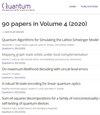海森堡有限多体哈密顿估计的稳定器代码
IF 5.1
2区 物理与天体物理
Q1 PHYSICS, MULTIDISCIPLINARY
引用次数: 0
摘要
估计多体哈密顿量在量子技术中有着广泛的应用。通过允许量子系统的相干演化和跨多个探针的纠缠,估计完全连接的k -体相互作用的精度可以扩展到$(n^kt)^{-1}$,其中$n$是探针的数量,$t$是探测时间。然而,在量子噪声下可能不再实现最佳缩放,为了恢复这一极限,应用量子误差校正是很重要的。本文研究了稳定量子纠错码在噪声条件下估计多体哈密顿量的性能。在估计单量子位噪声下的全连通$ZZZ$相互作用时,我们展示了三种稳定器码-薄面码、量子red - muller码和Shor码-分别实现了$(nt)^{-1}$、$(n^2t)^{-1}$和$(n^3t)^{-1}$的缩放,它们都是$t$的最优值。进一步讨论了稳定器结构与n标度之间的关系,并给出了若干不去定理。例如,我们发现具有等权稳定器生成器的代码最多可以实现$n^{-1}$缩放,而最优的$n^{-3}$缩放当且仅当代码具有重复代码子结构时才能实现,例如在Shor代码中。本文章由计算机程序翻译,如有差异,请以英文原文为准。
Stabilizer codes for Heisenberg-limited many-body Hamiltonian estimation
Estimating many-body Hamiltonians has wide applications in quantum technology. By allowing coherent evolution of quantum systems and entanglement across multiple probes, the precision of estimating a fully connected $k$-body interaction can scale up to $(n^kt)^{-1}$, where $n$ is the number of probes and $t$ is the probing time. However, the optimal scaling may no longer be achievable under quantum noise, and it is important to apply quantum error correction in order to recover this limit. In this work, we study the performance of stabilizer quantum error correcting codes in estimating many-body Hamiltonians under noise. When estimating a fully connected $ZZZ$ interaction under single-qubit noise, we showcase three families of stabilizer codes – thin surface codes, quantum Reed–Muller codes and Shor codes – that achieve the scalings of $(nt)^{-1}$, $(n^2t)^{-1}$ and $(n^3t)^{-1}$, respectively, all of which are optimal with $t$. We further discuss the relation between stabilizer structure and the scaling with $n$, and identify several no-go theorems. For instance, we find codes with constant-weight stabilizer generators can at most achieve the $n^{-1}$ scaling, while the optimal $n^{-3}$ scaling is achievable if and only if the code bears a repetition code substructure, like in Shor code.
求助全文
通过发布文献求助,成功后即可免费获取论文全文。
去求助
来源期刊

Quantum
Physics and Astronomy-Physics and Astronomy (miscellaneous)
CiteScore
9.20
自引率
10.90%
发文量
241
审稿时长
16 weeks
期刊介绍:
Quantum is an open-access peer-reviewed journal for quantum science and related fields. Quantum is non-profit and community-run: an effort by researchers and for researchers to make science more open and publishing more transparent and efficient.
 求助内容:
求助内容: 应助结果提醒方式:
应助结果提醒方式:


